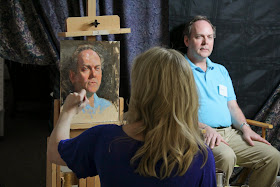1. I began "Passage" with a loose vine charcoal drawing on a white linen canvas prepared myself (see this blog post for more on making your own linen canvases). I used a thin tone of alizarin crimson and viridian. Again, I anticipated that some of the wash would show through in the final piece. I then set to work immediately on the face, hair and arm. As a portrait artist at heart, I can't usually work on the rest of the painting until I am satisfied that the face will turn out! This is as far as I got on day 1. As you can see, I've already established my lightest light (her shoulder) and darkest dark (under her elbow/behind her back).
2. I then worked on the hand and skull, trying to compare values and colors as accurately as possible to what was already established (face, hair, etc.). This is extremely important when coming back to work the next day, otherwise, it could end up looking like several different paintings in one rather than a solid, cohesive piece. I also tried to make sure my edges were interesting, working the background around the forms so that it looked soft and as if it were painted all at once. I began blocking in the sky (I suppose it looks like I was having a little too much fun!).
3. It's hard to tell from the photo, but there was a LOT of paint in the lights of the wings (a mixture of pure white and lemon yellow, with touches of radiant blue and green). I used a lot of colors in this painting that are not part of my typical portrait palette; for example, the sky is Sevres blue (by Rembrandt), and the earthy green darks throughout consist of lots of olive green (Winsor & Newton). The yellow in the sky is mostly cadmium yellow pale and white, with some alizarin at the edges for the pinker tones.
4. I moved on to the white dress, which really doesn't have that much white in it at all! The shadow areas are a symphony of blues, purples, and greens, all remaining on the warm side relative to the cool lights. I had to squint a lot to make sure the folds didn't stand out too much. I was also careful not to make the shapes redundant or too similar to each other. I scumbled in the gravestone, keeping the paint thin so that the canvas texture added to the feeling of age and wear. The feet and legs were blocked in with darker values than the head and arms, since they are further away from the light source. I also covered the bottom of the painting with a thin patchwork of olive green and transparent brown to suggest the general value and color of the grass.
5. Moving forward, I refined the feet and legs. Because of my chosen color scheme, I was surprised at how much blue I ended up using in the skin (usually for skin tones I favor viridian over blue unless painting an African American model, or bright reflected lights).
6. Here is the finished piece. I used Rosemary mongoose hair brushes to attain the softness in the feathers, and painted the edges of the wings and background at the same time.
"Passage" - 36x24" - oil
“Yes, death. Death must be so beautiful. To lie in the soft brown earth, with the grasses waving above one's head, and listen to silence. To have no yesterday, and no to-morrow. To forget time, to forget life, to be at peace. You can help me. You can open for me the portals of death's house, for love is always with you, and love is stronger than death is.” - Oscar Wilde, The Canterville Ghost




















































